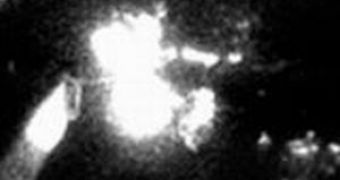Using latest technology, scientists have discovered "hotspots" of bioluminescence in deep sea, near the floor of the Atlantic Ocean, off the West coast of Ireland at 1000 m depth. So many animals were squirting luminescence into the water that football-sized balls of light were seen by the scientific team.
Even if 90 % of the deep-sea animals have light-producing organs, observation of these lights in action has been something unusual. The main light producing marine organisms are bacteria, protozoa, jellyfishes, crustaceans, squids and fish. Normally, these lights appear as flashes when stimulated by the agitation of water by boats or submarines, but in the new observation the shear number of light producing animals formed football ball sized luminescence water volumes.
Some balls had a vivid blue, while others had a mixture of green and red. "People tend to think of bioluminescence as something that happens at the surface of the sea, because that is where they usually see it. But in the deep oceans, this light is all many animals ever see because sunlight is too dim." said Dr Julian Partridge, expert in animal vision from the University of Bristol
"Millions deep sea of animals have evolved visual systems for communication using only brief flashes of dim light. It is often not known why the animals produce light, but the squirting of luminescent material is likely to be a defense mechanism."
"There has been trawling in the area by Scottish and Irish trawlers for years. Some deep-sea fish will flash in distress at having been caught. But nobody has realised there are these bright light displays on the sea floor below them."
The research team used a lander to record displays of bioluminescence emitted by abyssal animals gathered at bait attached to the lander. "This is the first time anyone has recorded spontaneous light emissions by bottom-living animals on the deep sea floor." said Professor Monty Priede, Director of Oceanlab.
"Previously, people had observed flashes of light from animals in the water disturbed by the approach of the submarine. Our lander stayed still, making no noise, and we got unique recordings of natural reactions of deep sea animals to food and each other."
"We have seen three kinds of displays - animals swimming along producing repeated flashes of light, single flashes of light, and animals squirting a luminescent substance into the water."
The scientists noticed that the bioluminescence phenomenon decreased with the depth, from 30 bioluminescence events per hour at 1,000 m to three at 4,000m. Professor Priede said: "We started this work when we noted that even the deepest living fishes in the oceans have eyes, but we had no idea what they might be looking at. " said Priede.
"We now know that throughout the abyssal sea floor there are occasional flashes of light but, where animals congregate at a food source, such as our bait, animals are communicating with one another through light. We imagine a dead whale that has fallen to the sea floor would be surrounded by lights making a vivid display in the darkness of the abyss which might attract predatory fishes. "
Two hotspots of deep sea bioluminescence were found till now in the Atlantic Ocean. Besides the Irish hot spot, another one was found at 3200m depth off tropical West Africa. During one observation made here, two animals were recorded apparently communicating through light flashes. The Irish hotspot is close to a deep cold-water coral reefs, called Belgica Mounds, and produces the most spectacular displays. "It was amazing to discover something so spectacular so close to home in waters we thought we knew very well" said Priede.
By now, scientists can only guess that the light source of these phenomena can be provoked by small deep sea crustaceans, 4 mm long. "While the predators are blinded or distracted by the ball of light, the shrimp makes its escape. So far we have only discovered two hotspots of deep sea light, we are convinced there is much more to be discovered" Priede added.
Photo credit: Monty Priede

 14 DAY TRIAL //
14 DAY TRIAL //